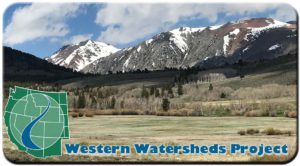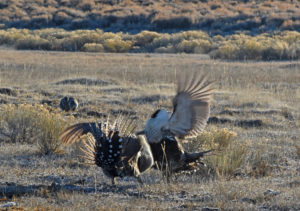
Dunderberg allotment, Photo L. Cunningham/WWP
We’re thrilled to announce that our advocacy paid off on 33,000 acres of scenic and biodiverse public lands in the eastern Sierra Nevada on the Humboldt-Toiyabe National Forest. The new decision removes the potential for new livestock impacts on the allotments, protecting the land for sage grouse, bighorn sheep, Yosemite toads, Sierra Nevada yellow-legged frogs, whitebark pine and other native plant and animal species. These slopes and streams are in the ancestral homeland of the Bridgeport Paiute and other Paiute and Shoshone people, and serve have cultural and recreational values that would be impaired by new livestock use.
The Forest Service had been reviewing whether to initiate cattle grazing on the Bridgeport-Southwest Rangeland Project, an area where domestic sheep grazing had already been discontinued because of the disease threat to Sierra Nevada bighorn sheep. The rare high elevation habitats had been recovering from livestock impacts for approximately fifteen years. Instead of allowing new cattle grazing on the allotments, the agency selected the “No Action Alternative,” which does not allow any type of livestock grazing and does not authorize the reconstruction of water sources.
The decision also cites to prohibitions on the placement of livestock waters within 0.6 miles of a riparian area, since the rangeland proposal wouldn’t have been able to adhere to this standard for Bi-State sage grouse habitat protection. New livestock infrastructure could would not have been lawful under the Bi-state sage grouse plan amendment that WWP and others fought so hard for.
It’s a big win for the lands in question and the species who have come to rely on livestock-free habitats. Additionally, the decision contains some strong language about land management:
“Not all NFS lands are intended to be managed for all uses. It remains within my discretion as the Responsible Official to identify which NFS lands are utilized for which resource objectives and outputs, consistent with Forest Plan direction and all law, regulation, and policy, and to do so in a way that does not impair the productivity of the land. Livestock grazing is only one aspect of the Multiple Use Sustained Yield Act.
I feel my decision to select the No Action alternative is in keeping with the spirit of the Multiple Use Sustained Yield Act because not authorizing conversion to cattle grazing enhances the ability of NFS lands in the project area to provide high quality habitat for terrestrial and aquatic wildlife species as well as watershed protection. These ecosystem benefits and natural resource values were highlighted repeatedly in responses received during scoping and public comment periods. I have decided the protection of threatened and endangered species populations and habitats as well as water resources provided by NFS lands in the project area is of far greater relative value to the American public than the potential benefits realized from livestock production.”
We couldn’t agree more, and we’re proud to have been one of the organizations that pushed throughout the process for this outcome.






